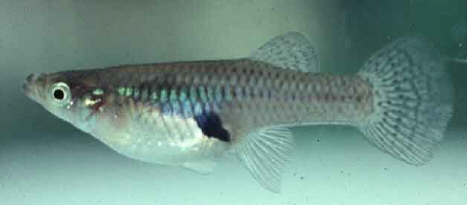It turns out that the American mosquitofish can count up to four - but no more. "Fish demonstrate primitive mathematical abilities," says the study's editor from the University of Padua in Italy

According to Wikipedia, common gambusia (Gambusia affinis) is a predatory fish that originates from the southern United States and northern Mexico, and which feeds on algae, plants and various invertebrates, from aquatic insects to other small fish. It is used as a mosquito repellent that transmits fever and is also known as 'mosquito fish'. For this purpose, man brought the gambosia to different parts of the world and thus the fish also arrived in Israel in 1926 by the English as an aid to the fight against malaria.
Last year, Agrilo and his colleagues showed that if a female mosquitofish is harassed by a male, she will try to ignore him and seek shelter within a large school, proof that these fish can differentiate between large schools and smaller schools.
The team conducted a series of experiments to see if a single mosquitofish would prefer to join a group of between two and four other fish. The result, published in the British Telegraph, showed that the females preferred to join groups that were larger by one fish than other groups, and were more likely to prefer groups with four fish over groups with three fish, and groups of three fish over a group containing a pair of fish.
Another series of experiments revealed the ability of the fish to process larger numbers. The fish could not directly count above four, but had the ability to distinguish large numbers if the groups were separated by a 2:1 ratio. For example, they could distinguish between a school of a dozen fish and a school of six fish, but not between a school of a dozen fish and a school of eight fish - a ratio of 3:2. This demonstrates that the fish can visually estimate large numbers, but not count them accurately.

14 תגובות
To Dr. Roy Lerner
It is not true that all Haredim only know how to count up to four, for example, Shas can count up to at least five hundred million shekels.
Sabdarmish Yehuda
to ask:
Your assumption is fundamentally wrong because it assumes that the fish understand the number 42 according to base 10 and this is not the case because they understand this number according to base 5.
proof:
Since they know how to count to four, and assuming that they know what zero is (still requires proof), then they know how to count according to a base of 5. Hence the number forty-two in the fish signifies for them what for us according to base 10 is the number 22 (4*5 plus 2 ).
If we really intended for them to understand the meaning of life according to the "Hitchhiker's Guide to the Galaxy" we should have explained to them that the meaning of life (according to base 5) is the number 132.
The more important question - does the fish understand the meaning of life in general or only on its way to the plate.
Have a good weekend
Sabdarmish Yehuda
Come on, you're not funny at all and you're also fooling around
Netanyahu and the ultra-Orthodox can also count to 4...
borrowed
There is a more efficient method of computing large prime numbers using someone else's problem field generating device isn't there?
The results were not decoded correctly.
In the 'Hitchhiker's Guide to the Galaxy' it is written that the meaning of life and all that is 42. The fish tried to explain the meaning of life to the researchers, they 'transmitted' the number 4, and now they will move on to transmitting the number 2.
It was found, therefore, that the fish have a much more developed mathematical ability than the researchers concluded; It's just that the fish didn't talk to the researchers about mathematics but about philosophy.
A more advanced insect will discover that the fish can calculate prime numbers at incredible rates, multiply them, and even translate the results into binary representation; Therefore the 'transmissions' of the fish will only be 0 and 1.
Bye
This study is strikingly reminiscent of the study of the Kurdish scientist and the fly.
They should be shared in the Mitzvah tests to raise the average
The ability of the fish exceeds the equivalent counting ability of most students in the Israeli education system. Cheers to the hi-tech fish...
My parrot fish counts to five and knows how to rhyme Mozart
grade retarded
The flowers for the IDF!
I had an amazing idea
Make a fishing rod with five hooks, the fish will count four, get confused on the fifth, and that's how we can fish them.
Good night
Sabdarmish Yehuda
Interesting research..
If we put humor into the matter, then surely those who chose the smaller groups were minnows (female fish?) blondes...